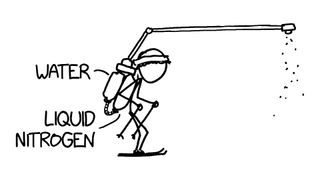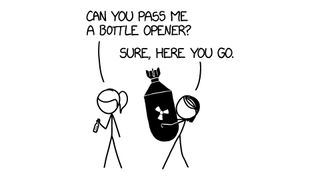Useless Self-Help Guide Offers Ludicrous Solutions to Everyday Problems
Learn to ski, power your home on Mars or build the backyard lava lake you've always wanted.

NEW YORK — Have you ever wondered how to predict the weather, land an airplane onto a moving train, or knock a drone out of the sky with sports equipment? Randall Munroe, creator of the popular science webcomic xkcd, has a new book that presents outrageous solutions for a broad range of problems, from the mundane to the unusual.
In "How To: Absurd Scientific Advice for Common Real-World Problems" (Penguin Random House, 2019), Munroe tackles challenges that are often a part of everyday life. He shared highlights from the book with a rapt audience at New York Comic Con on Oct. 3.
Be forewarned: None of his suggestions is easy — in fact, they're about as convoluted and complicated as possible. Let's say you want to cross a river, which you could accomplish by simply swimming across. Munroe offers interesting but less practical options: jumping the river in a car; freezing the water or boiling it away; and flying from bank to bank on a string of kites. And he uses science to explain how each of these options might be possible (if not necessarily practical).
Related: 25 Weird Things Humans Do Every Day, and Why
"I'm one of those people who always comes up with impractical solutions to things — but usually, I'm not trying to come up with an impractical solution," Munroe told Live Science. Rather, he's looking for timesavers for tasks that are boring and repetitive "something that would take a little while now to get set up, but once I did it could actually save me time in the long run," he explained.
"And whenever I find myself thinking 'save me time in the long run,' I know I'm about to do something that will definitely take up more time than it could possibly save," he said.

Do you need to move to a new home? You could hire a moving truck and pack everything into bags and boxes. But perhaps you'd rather not pack, and you'd prefer to just move your entire house? In that case, you might try lifting your home with a quadcopter — four helicopters fixed to a rigid frame — an engineering challenge that was actually investigated by the U.S. military during the Cold War, Munroe wrote.
Sign up for the Live Science daily newsletter now
Get the world’s most fascinating discoveries delivered straight to your inbox.
What if you were on an airplane, and you needed to make an emergency landing? Munroe turned to retired Canadian astronaut Col. Chris Hadfield for answers; Hadfield is also a test pilot who has flown about 100 different types of aircraft for the Canadian and U.S. militaries, Munroe told the audience at Comic Con.
Naturally, Munroe came up with the weirdest emergency-landing scenarios that he could think of, with every question just a little more ridiculous than the one before: from landing a plane on a ski jump ("you'd have to time it just right") to landing the International Space Station ("odds are slim to none").
"The joke was on me, because he [Hadfield] just answered all of them immediately," Munroe told Live Science. "And a lot of the answers were, 'Oh yeah, I've done that.'"
Related: 'Star Wars' Tech: 8 Sci-Fi Inventions and Their Real-Life Counterparts
Munroe also enlisted the help of an expert to investigate the best way to knock a drone out of the sky, calling on tennis champion Serena Williams to lend a hand (and a racket) when he couldn't find good data about the accuracy of hitting targets with a tennis serve. Williams obliged, striking a drone from a distance of 40 feet (12 meters) on her third try.
However, even Williams agreed that just because it was physically possible for her to disable a drone with a tennis serve, it probably wouldn't be her go-to method should the situation ever arise, Munroe told the Comic Con audience.
"I asked her, 'What do you think of this idea as a way of shooting down drones?' She said, 'I think it's a pretty bad idea,'" Munroe said.
Then again, sometimes so-called bad ideas get the job done. Consider the prospect of gently lowering a rover onto the surface of Mars with a hovering space-crane; though this initially sounded ludicrous, NASA successfully used this method to send Curiosity to Mars in August 2012, Munroe told Live Science.
"With NASA's discussion of their Curiosity rover, they said, 'No one's ever tried this before, and it did seem crazy to us when we thought of it. But every other idea had some fatal flaw and this one didn't,'" he said.
"It was neat seeing them admit they thought this was just as weird as we did — but they had done the math, and it looked like a good idea, and then it actually worked! So, sometimes these ideas do work out," Munroe said.
"How To: Absurd Scientific Advice for Common Real-World Problems" is available to buy online at Amazon, Barnes & Noble and other booksellers.
- 25 Fun Facts About Science & History
- Top 10 Inventions That Changed the World
- 8 Weird Statistics About Daily Life
Originally published on Live Science.


Mindy Weisberger is an editor at Scholastic and a former Live Science channel editor and senior writer. She has reported on general science, covering climate change, paleontology, biology, and space. Mindy studied film at Columbia University; prior to Live Science she produced, wrote and directed media for the American Museum of Natural History in New York City. Her videos about dinosaurs, astrophysics, biodiversity and evolution appear in museums and science centers worldwide, earning awards such as the CINE Golden Eagle and the Communicator Award of Excellence. Her writing has also appeared in Scientific American, The Washington Post and How It Works Magazine.
